|
Next to the loss of habitat, alien invasion—the introduction
and spread of species not indigenous to a location—is the
leading cause of species endangerment and extinction.
Here, read about the 10 plants and animals that have significantly
altered habitats following their introduction.
 Cane toad (Bufo marinus)
Cane toad (Bufo marinus)

|
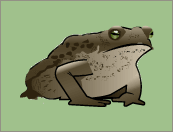
|
|
The cane toad competes with native amphibians and is also
highly toxic. It excretes toxins as a way to protect itself
against predators, and it may sicken or kill small animals
(including cats and dogs) that bite it. Native to the southern
U.S., Central America, and northern South America, these
animals have spread to Australia and some islands in the South
Pacific.
Cane toads were deliberately introduced to Queensland,
Australia, in 1935 to control two beetle pests of sugarcane.
With no natural predators, the toads quickly spread. They were
not effective at controlling the beetles.
|
 Crazy ant (Anoplolepis gracilipes)
Crazy ant (Anoplolepis gracilipes)

|

|
|
The crazy ant, which originated in either Africa or Asia
(scientists are not sure which), is found in many cities in
the tropics, in parts of the U.S., and on many tropical
islands from Hawaii to Zanzibar. On Christmas Island in the
Indian Ocean, its kind live in "supercolonies" and prey on red
crabs. Crazy ants have killed as many as three million crabs
in one 18-month period there.
The crazy ant, which gets its name from its rapid and erratic
movement, also preys on insects, reptiles, birds, and small
mammals. Hordes of crazy ants have even been known to attack
and kill pigs and dogs. In the fall it eats the sugary
droppings of sap-sucking insects such as aphids and mealybugs,
which it protects from predators. Left unchecked, these
insects increase in numbers, resulting in damage to the
rainforest canopy.
|
 Feral pig (Sus scrofa)
Feral pig (Sus scrofa)

|
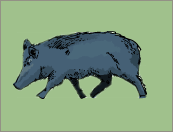
|
|
Ancestors of the feral pig made their way back to the wild,
either by escape or release. Found in many parts of the world,
the feral pig damages crops by trampling and "rooting." It
attacks and feeds on livestock (mainly lambs) and causes the
spread of weeds. It also spreads diseases such as
leptospirosis and foot-and-mouth disease. Feral pigs feed
primarily on plants but also on earthworms, insects,
amphibians, reptiles, and birds.
|
 Miconia (Miconia calvescens)
Miconia (Miconia calvescens)

|
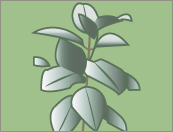
|
|
This plant from Central and South America was brought to
Tahiti in 1937 and planted in a botanical garden. Fruit-eating
birds have spread its seed, and now miconia covers more than
half the island. It has become the dominant canopy tree in
Tahiti, shading out many native plants. Unlike the island's
indigenous trees, it has a shallow root system, which has led
to landslides where the trees have grown on hillsides. It
thrives in the tropical climate and spreads quickly. In its
native habitat of Central and South America, fungi and insects
control its spread.
|
 Purple loosestrife (Lythrum salicaria)
Purple loosestrife (Lythrum salicaria)

|
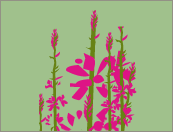
|
|
This plant from Europe and Asia came to North America in the
early 1800s on the wool of European sheep and within ships
that used soil as ballast. It was also brought as an
ornamental plant and as a source of nectar for bees kept by
beekeepers. By the 1830s the plant was common along the east
coast of the U.S. Purple loosestrife is now found throughout
most of the U.S. and Canada. It spreads rapidly and invades
wetlands by displacing native plants, creating an environment
that provides little food or shelter for native wildlife.
|
 Small Indian mongoose (Herpestes auropunctatus)
Small Indian mongoose (Herpestes auropunctatus)

|
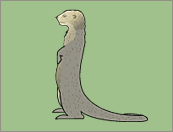
|
|
This predator, which is native to areas from Iran to
Indonesia, was introduced to several locations in the 1800s to
control rats, another invasive species. It was first brought
to Puerto Rico in 1877 to control the black rat. Since then it
has caused the extinction of seven species of reptiles and
amphibians on the island. The small Indian mongoose also
spreads diseases such as leptospirosis. It can make its home
in a range of habitats, from forests to open plains.
The small Indian mongoose is now found in Costa Rica, Hawaii,
Fiji, the islands of the Caribbean, and other places around
the world.
|
 Mosquito fish (Gambusia affinis)
Mosquito fish (Gambusia affinis)

|
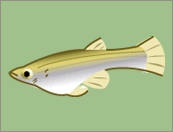
|
|
The mosquito fish, a guppy-like fish that grows up to three
inches long, may look harmless, but it has become a pest
around the world. Native to the eastern and southern U.S., it
was originally introduced in many areas to control mosquitoes,
but it also feeds on the eggs of many commercial and rare
fish. Moreover, it is an aggressive little fish that attacks
other fish, big and small alike. Although the mosquito fish is
an invasive species, using it to control mosquito larvae in
ornamental ponds, unused swimming pools, and animal troughs is
still considered acceptable.
|
 Strawberry guava (Psidium cattleianum)
Strawberry guava (Psidium cattleianum)

|
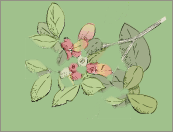
|
|
The strawberry guava, which is native to the Atlantic coast of
Brazil, has now spread to Polynesia, Mauritius (an island in
the Indian Ocean), Hawaii, Puerto Rico, and other tropical
locations around the world.
In Hawaii, the feral pig, another invasive species, assists in
the spread of strawberry guava by eating its fruit and
dispersing its seed. The plant was brought to Hawaii (and
elsewhere) for its edible fruit but soon after its
introduction escaped from gardens. A shrub or small tree that
can reach 15 feet in height, the plant not only shades out
underlying native vegetation, it also sends out feeder roots
that inhibit native plants' growth. In Hawaii, strawberry
guava is considered an especially invasive plant pest.
|
 Zebra mussel (Dreissena polymorpha)
Zebra mussel (Dreissena polymorpha)

|
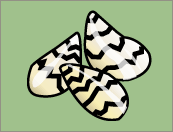
|
|
This species arrived in the lower Great Lakes of the U.S.
either attached to the hulls or loose in the ballast water of
oceangoing ships. Zebra mussels can filter nearly a quart of
water a day. As they do so they feed on plankton, consuming
food that native shellfish rely on for their survival. They
clog the piping systems of industrial plants and power
utilities and can interfere with locks and dams on rivers.
Zebra mussels also damage boat hulls and engines.
Native to the Caspian Sea in eastern Europe, the zebra mussel
first appeared in Britain in 1824. Since then it has spread to
Ireland, Denmark, Sweden, Finland, Italy, and much of western
Europe. It first appeared in the Great Lakes in 1988.
Interestingly, since its introduction to Lake Erie, the lake
has become noticeably clearer, allowing for deeper sunlight
penetration and an increase in aquatic plant life.
|
 Water hyacinth (Eichhornia crassipes)
Water hyacinth (Eichhornia crassipes)

|

|
|
Native to South America, water hyacinth is one of the worst
invasive species known. It spreads at extremely fast rates, in
favorable conditions doubling its numbers in as little as 12
days. The plant, which floats on the water's surface, can
cover large areas, thus limiting boat traffic, swimming, and
fishing. By blanketing the surface, the plant also prevents
sunlight from entering the water. Moreover, when it dies, the
decaying plant matter robs the water of oxygen. The reduced
amount of sunlight and oxygen in the water disrupts plant and
animal life, adversely affecting the habitat's biodiversity.
|

|
|

